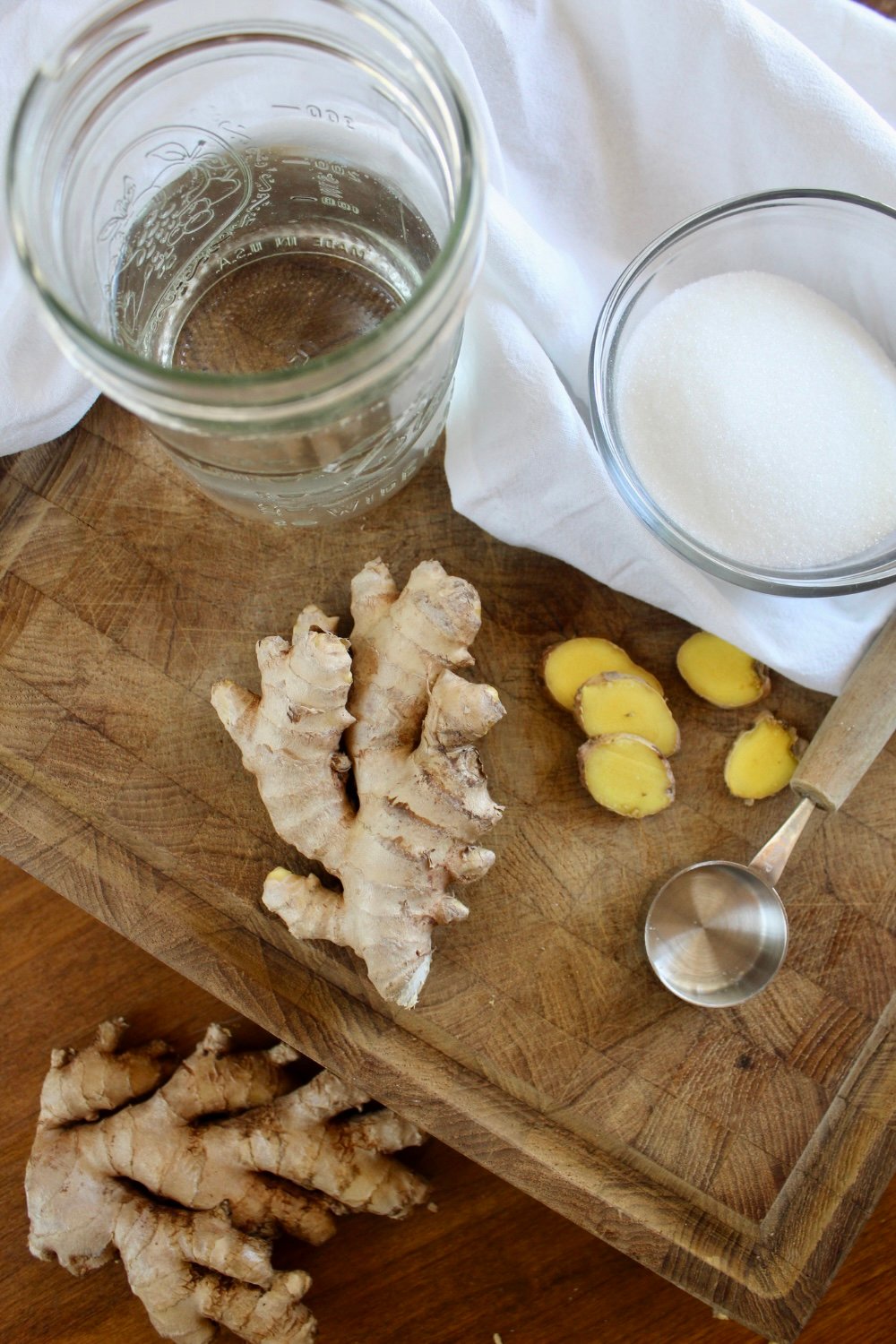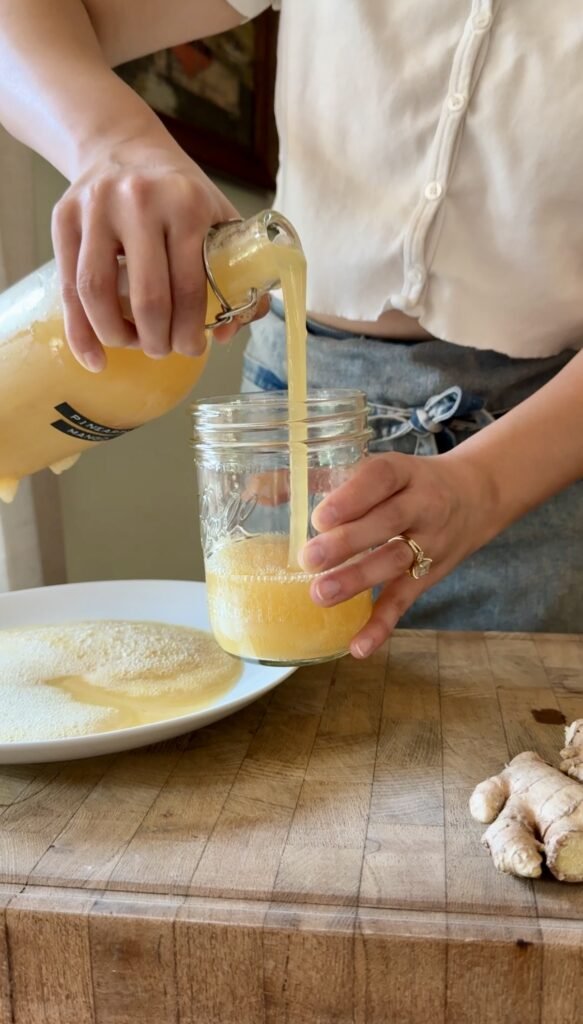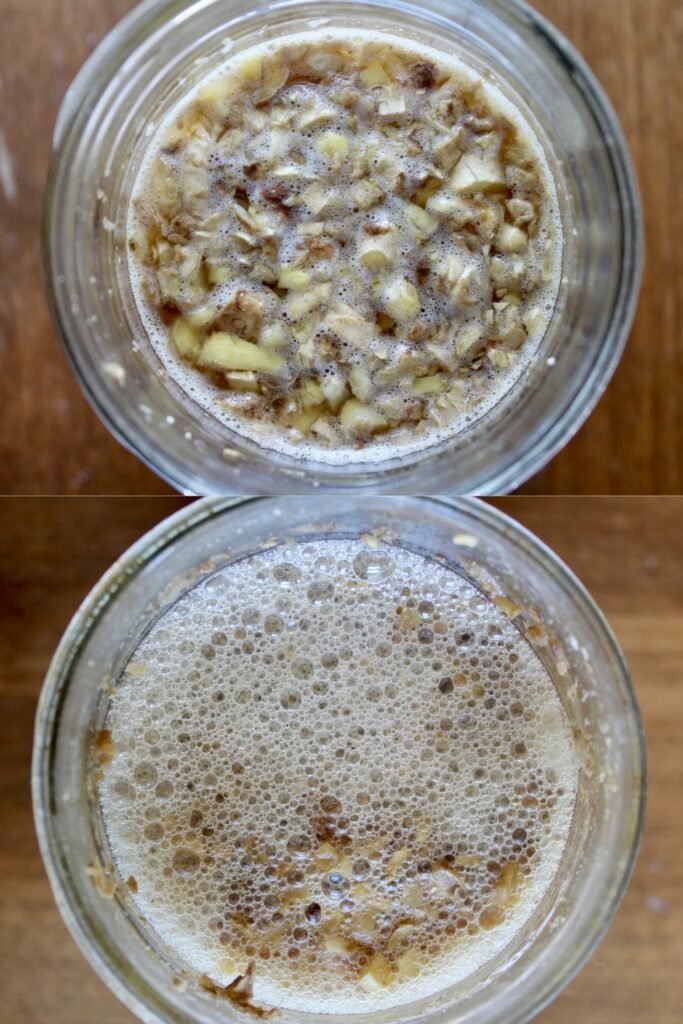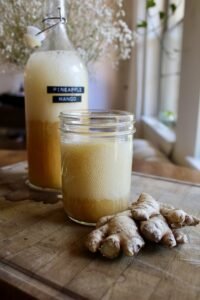GINGER BUG PROBIOTIC SODA
August 25, 2025
In our kitchen, I love finding ways to bring old-fashioned traditions back to life, and the ginger bug has quickly become one of my favorites. With just ginger, sugar, and water, you can create a bubbly starter that turns simple drinks into naturally fermented sodas. It’s a small, everyday reminder that the healthiest foods often come from the simplest ingredients.

What is a Ginger Bug?
A ginger bug is a traditional starter made from just three simple ingredients: fresh ginger, sugar, and water. When combined, they capture wild yeasts and beneficial bacteria from the ginger’s skin and the air around us, creating a bubbly, living culture. This culture acts much like sourdough starter does for bread — it becomes the base you can use to ferment other foods and drinks. Once it’s active and fizzy, a ginger bug can be added to sweetened liquids to transform them into naturally carbonated, probiotic-rich beverages.
Beyond being a fun kitchen experiment, a ginger bug connects us back to the roots of old-fashioned food preservation. Long before commercial yeast and sodas existed, families used simple fermentations like this to create refreshing drinks with natural fizz.
Natural Probiotic Boost
A ginger bug is packed with wild yeasts and beneficial bacteria that help support gut health. Just like sauerkraut or kombucha, it brings balance to digestion while adding a natural fizz to your drinks.
Why Make A Ginger Bug?
One of the biggest reasons to make a ginger bug is the natural probiotic boost it provides. As the ginger, sugar, and water ferment, they develop colonies of beneficial bacteria and wild yeasts that are similar to those found in kombucha, kefir, and sauerkraut.
These good microbes support digestion by helping balance the bacteria in your gut, which can improve nutrient absorption, calm bloating, and strengthen overall gut health. Unlike store-bought sodas that often disrupt the microbiome with additives and excess sugar, ginger bug drinks actually work with your body to restore balance.

How to Make a ginger bug
Making a ginger bug is simple, but it does require a little patience and daily attention. Think of it like sourdough starter — you’re building up a living culture that will keep rewarding you as long as you care for it. Here’s how to begin:
Prepare your jar – Use a clean pint-sized glass jar. Prepare a cover for the jar, I like to use a breathable cloth secured with a rubber band or mason jar ring.
Add the first ingredients – Combine 1 cup of filtered water (cold or room-temp), 2 tablespoons of freshly grated or finely chopped ginger (skin on), and 2 tablespoons of sugar in the jar. Stir well with a wooden spoon.
Cover and rest – Place the jar in a warm spot out of direct sunlight. Leave it lightly covered so the wild yeasts in the air can join the fermentation process.
Feed daily – Each day for about 3–5 days, add 1 tablespoon of fresh ginger and 1 tablespoon of sugar. Stir well to keep oxygen circulating.
Watch for bubbles – By day 3, you should see small bubbles rising to the surface and notice a lightly yeasty, fruity aroma. This means your ginger bug is alive and active.
Use – Once bubbly, strain a portion of the liquid to use in soda recipes. Keep the rest in the jar, continuing to feed daily if you want to leave it on the counter.

Ginger Bug Long-term Storage
If you don’t plan to use your ginger bug for a while, give it one last feeding and store it in the fridge. When you’re ready to use it again, bring it back to room temperature and feed it as before daily until the bubbles return — usually within about 3 days.
Tips for success
Choose the right sugar: Cane sugar, white sugar, or light brown sugar work best because they feed the yeasts easily. You can use raw sugar or coconut sugar but these ferment more slowly. Avoid honey because it is naturally antibacterial can interfere with fermentation. Also, avoid artificial sweeteners — they won’t feed your bug at all.
Leave the skin on your ginger: The peel is where many of the natural yeasts and bacteria live. Organic ginger is best, since conventional ginger is sometimes treated to slow sprouting, which can also slow fermentation.
Consistency is key: Feed at the same time each day and stir well. This introduces oxygen and prevents dry ginger from floating and molding on the surface.
Listen to your bug: A healthy ginger bug will bubble and smell pleasantly yeasty or gingery. If it develops a strong, unpleasant odor or shows fuzzy mold on the surface, it’s best to discard it and start fresh.
Not Bubbling: A ginger bug may take longer to bubble, especially in cooler kitchens — sometimes up to a full week instead of just a few days. Keep feeding it daily with ginger and sugar, stir well, and move it to a slightly warmer spot to help the natural yeasts wake up.
Don’t use metal during fermentation
void using metal utensils when stirring your ginger bug. Metal can react with the acids produced during fermentation and may weaken or harm your culture over time. A wooden spoon or silicone spatula is the safest choice.
Best Juices to Use with a Ginger Bug
Great Options that ferment well:
Fresh fruit juices: apple, pineapple, grape, orange, pear, and pomegranate all ferment beautifully and make crisp, fizzy sodas.
Berry juices: strawberry, blueberry, raspberry (work best blended and strained so there’s not too much pulp).
Citrus blends: lemon or lime with added sugar (since straight lemon/lime is too acidic on its own).
Things to Pay Attention To:
Sugar Content – The ginger bug needs natural sugar to keep fermenting. If you use low-sugar juice (like lemon), add 1–2 teaspoons of cane sugar per cup so the culture has food.
Preservatives – Avoid juices with potassium sorbate, sodium benzoate, or sulfites. These preservatives are designed to stop fermentation and will often kill your bug.
Fresh vs. Bottled – Fresh-pressed juices or 100% juice without additives work best. Store-bought juices are fine if they’re preservative-free.
Pulp – A little pulp is okay, but too much can cause cloudiness or sediment. Strain if you want a cleaner, sparkling soda.
Fun Flavor Ideas:
Apple juice with a touch of cinnamon and ginger bug ferments into a crisp, spiced soda that’s warm and cozy without being heavy. Pineapple juice with fresh mint makes a clean, bright soda that’s lightly tropical and refreshing.
Explore some of my favorite recommended products to support your health journey (displayed on this page as affiliate links), and remember to always consult a healthcare professional before making any changes to your diet or lifestyle—full medical disclaimer here.


Ginger Bug Probiotic Soda
EQUITMENT
- 1 32 oz Glass Swing-top Bottle see note below for different sizes
INGREDIENTS
- 8 tbsp ginger bug (4oz) see ginger bug recipe above
- 4 cups fruit juice contains sugar
DIRECTIONS
- Clean or sterilize swing top glass bottle.
- Pour in ginger bug and then the juice. Make sure to leave at least a 1 inch head space.8 tbsp ginger bug (4oz),4 cups fruit juice
- Seal the bottle and leave it at room temperature for 1–3 days, depending on how warm your kitchen is. Check daily for bubbles and pressure.
- Carefully “burp” the bottle once a day by opening it slightly to release pressure, then reseal. When it’s bubbly to your liking, move it to the refrigerator.
- Refrigerate a couple hours. Serve chilled over ice. Your soda will keep for about a week in the fridge, though it’s best enjoyed fresh and fizzy. Enjoy!
NUTRITION
I don’t track every nutrient or calorie I eat, but I do care about supporting my gut health naturally. This ginger bug is made from just three simple ingredients — fresh ginger packed with antioxidants and anti-inflammatory compounds, natural cane sugar that fuels the wild yeasts, and clean filtered water. Together, they create a living culture full of beneficial bacteria that can aid digestion, boost immunity, and support nutrient absorption. It’s a simple starter that lays the foundation for homemade sodas that actually nourish your body. Here’s more on why these nutrients matter →
